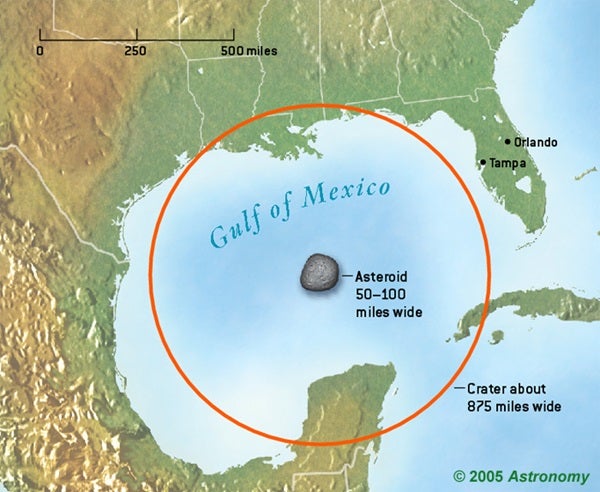The Gulf of Mexico is the result of plate tectonics, or “continental drift,” in which the plates comprising the Earth’s crust change position over time. The Gulf did not even exist in the distant past, and its size and shape will slowly change as time progresses and tectonic plates move.
To simplify matters, let’s replace the Gulf with a perfectly circular sea having the same total area. The Gulf has an area of about 600,000 square miles (1,554,000 square kilometers), which means we can replace it with a circular sea 875 miles (1,410 km) across. Now, there are two ways to estimate the size of an impacting object from the size of the resulting crater. The first is an old rule of thumb: An asteroid or comet will make a crater about 10 times its size, or in this case, 87.5 miles (141 km).
A more rigorous approach is to adopt mathematical relations for crater size developed from nuclear weapons tests. With some assumptions on the ground composition, this will give us the explosive energy needed to make the crater, and we can translate this number into the body’s size by assuming an impact speed. To form a Gulf-size crater in rocky soil, the energy required is 14 trillion megatons. If we assume an impact speed of 45,000 mph (72,000 km/h), the culprit body must be about 51 miles (82 km) across.
Both numbers are estimates. The rule-of-thumb approach ignores the body’s impact speed, the composition of the ground at the place of impact, and the composition of the comet or asteroid, among other things.
The second method is designed to account for some of these variables, but it is based on nuclear tests with relatively small explosive yields — at least in comparison to the impact energies we’re discussing — and there’s no way to validate the results at such energies.
However, the fact that the two numbers are in the same ballpark suggests our estimates probably aren’t too far off. So it would take a comet or asteroid between 50 and 100 miles (80 to 160 km) across to produce a crater the size of the Gulf of Mexico.
— BILL COOKE, MARSHALL SPACE FLIGHT CENTER, HUNTSVILLE, ALABAMA










